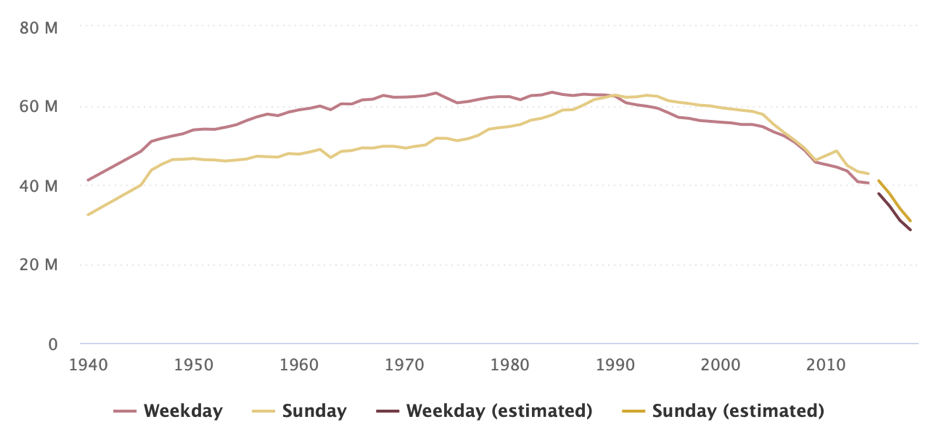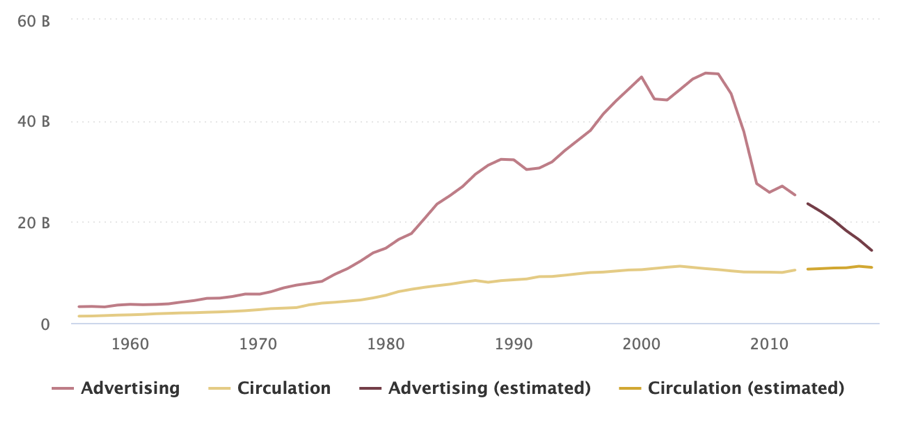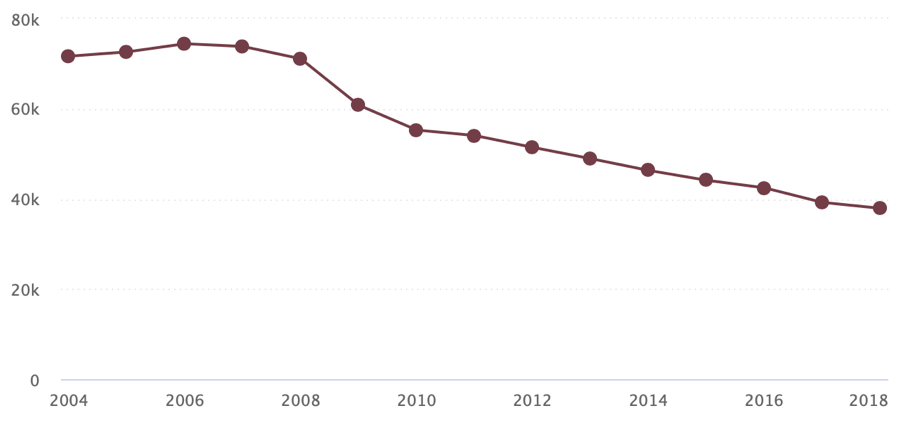Introduction
It is enough to look around to see how much the world has changed in recent decades. What was relevant at the end of the twentieth century is not being used by modern humans because of the existence of more convenient, cheaper, and functional analogs. Today, there are, in fact, fundamental changes in the lifestyles of billions of people, as society is deeply digitalized. There is no doubt that this sort of change has had a significant impact on all areas of society. By consciously ignoring the fastest growing industries, the author focuses on the newspaper industry.
It is worth admitting that, along with the high popularity of electronic information resources, newspapers are still in circulation, although it is impossible not to note their markedly reduced circulation. Prerequisites for the newspaper industry to cease to exist as a phenomenon in the coming decades are very high, but it is unlikely to happen so soon. Undoubtedly, traditional newspaper media, read by passengers on the subway, by family members at breakfast or by people in the park, are rapidly losing their relevance, with the most breakthrough publications seeking to follow the trends of an evolving society. It is worth saying that this is made possible by careful strategic planning.
Strategic planning is used in order to maintain the relevance and competitiveness of enterprises during the planned period. Hardly any of Roosevelt or Kennedy’s contemporaries suspected that in more than half a century, the ordinary life of humanity would undergo such radical changes. With sufficient knowledge and competence, marketing, political, and business professionals can predict what will remain relevant in the coming years and what should be abandoned as soon as possible. Strategic planning determines what a company needs to do right now to achieve its desired goals in the future, by reason of the fact that the environment and the organization itself will change.
The use of strategic planning theory in the print newspaper industry is a central objective of this paper. In particular, the following sections will examine in detail the trends in traditional media, the reasons for the marked decline in popularity, and propose steps to keep the Chronicle Gazette relevant.
Current State of the Newspaper Industry
The globalization of society, along with the in-depth digitalization of all spheres of life, has severely affected the newspaper sector. This section will discuss what exactly happens to print gazettes in the modern world. Nevertheless, it is of paramount importance to determine how much has changed the very essence of the newspaper.
The most primitive gazette print media probably appeared before the common era, when commanders and kings were publishing state news for the aristocratic community on papyrus. Such “newspapers” were incredibly valuable because they had an extremely limited circulation. Two millennia later, the value of the newspaper, just like the idea, remained the same overall: with a few pages of paper, the readers are informed about what is going on around them. Naturally, the modern person has many more options to get more prompt and reliable material.
In order to assess the nature of changes occurring with traditional print media, one should refer to statistics and figures. Thus, the leading indicators by which to evaluate the success and popularity of gazettes are their circulation, income from advertising, and the number of professional staff employed in this industry. It is enough to refer to Barthel (2019) to understand that newspapers have been in serious trouble in recent years. In particular, as illustrated in Figure 1, there has been a downward trend in the total circulation of weekday gazettes over the past eighty years. In numerical terms, this means that their circulation has decreased by more than 35 percent over the last ten years. It should be admitted that this trend is not of a periodic nature, because every next year, since the spread of Internet technologies, newspaper distribution has been steadily declining.

On the other hand, there is no doubt that the traditional media live off the advertisement placed there. The scheme of making such profit is that the advertiser pays a cost for the fact of publishing a column of advertising information that the reader consumes. This appears to be a win-win situation for each party: the business gets advertising, the gazette gets money, and the reader gets opportunities.
Nevertheless, due to a noticeable reduction in circulation, including a reduction in the number of readers, advertisers have begun to invest less in newspapers. According to Barthel, between 2018 and 2017, total revenue from print advertising fell by 13 percent (Figure 2). With some assumption, this can be interpreted as a 13 percent shortfall in this sector over the past two years, which has undoubtedly had an impact on its development.

An equally important indicator that demonstrates the success of a particular industry is the number of employees hired in that area. It does not seem surprising that the newspaper business shows negative trends in this too. Barthel cites figures showing that between 2004 and 2020, the number of workers in the gazette sector fell by more than 50 percent, from 71640 to 37900 (Figure 3).
In comparison, television broadcasting witnessed a positive employment trend between 2015 and 2020, with the total number of employees exceeding 125,000 in 2020 (Ibis World 2020). Based on the above three parameters, it is not difficult to conclude that the gazette industry is currently experiencing a rapid decline in popularity. If such trends continue or even intensify, there is a severe risk of crisis for the entire newspaper sector. Thus, the gazettes, which are not widely quoted, may cease to exist already in the nearest years.

Situation With Market Leaders
Despite the scale and range of economic and political advantages that large publishers can enjoy, the last few years have also seen a decline in the circulation and profitability of print newspapers. According to Watson (2020), between 2017 and 2019, the most prominent gazettes, such as USA Today, The Wall Street Journal, and The New York Times, experienced a marked decline in the amount of copies printed. The most significant damage was caused by Chicago Tribune: during the reporting period, the company reduced its circulation by more than 200 thousand copies.
For The New York Times, one of the most popular media, the situation does not seem much better. Over the past twenty years, the newspaper’s circulation fell by more than 60 percent to 443,000 copies in 2019. As can be seen from the above figures, the leaders of this sector are also characterized by a decline in popularity, and consequently, large companies emphasize the transfer of information to the digital equivalent.
Reasons for the Rapid Circulation Fall
External Evaluation
Technological Forces
There is no doubt that the technological revolution of recent decades has dramatically influenced the gazette sector. People choose digital media daily for a variety of reasons. First and foremost, information published on websites or social media is more recent. It took society a few minutes to learn about the chemical explosion in Beirut, while newspapers could not print the news until hours later.
On the other hand, the digital equivalents of gazettes are more user-friendly. In order to find the correct material, the user needs to enter keywords in the search box and select what is of interest to them. In the case of traditional newspapers, the buyer went to the kiosk and searched for the copies that covered the desired topic. Finally, the format of paper gazettes is inconvenient to use since the pages are too large, and the text is not customizable. Standard newspapers were produced on large paper canvases, and their reading was difficult for consumers. Conversely, using a smartphone, tablet, or laptop to track information solves the problem of adaptability and minimalism. These three technological forces justify the rapid decline in the circulation of printed newspapers along with digital media.
Economic Forces
An equally important factor affecting the overall decline in print media circulation and profitability is economic forces. It is worth understanding that traditionally a gazette is bought by readers who want to spend their leisure time learning new information or distract from their surroundings: in other words, reading newspapers is a sort of entertainment. At the same time, one has to pay for any entertainment, and according to Benton (2019), the cost of a newspaper copy has more than doubled compared to 2010.
However, if to believe Desilver (2018), for the same period, for most Americans, the salary remained the same, taking into account the general inflation. In other words, Americans have half the financial capacity to buy a newspaper and therefore choose to use free publications, including digital ones.
It is worth admitting that the digital gazette market is inversely related to print one: the lower the circulation of traditional newspapers becomes, the higher the readability of digital newspapers. This means that the public consciously chooses to consume information in the form of texts or audiovisual formats on websites, which is why publications decide to invest more effort in these industries than in ordinary paper newspapers.
It should be borne in mind that unemployment rates have an impact on the development of the sector. In the first two quarters of 2020, there was a sharp jump in the number of unemployed citizens, with the potential to reduce government GDP and not meet the output plan (Trading Economics 2020). In other words, it means that the high level of unemployment in the country will have a negative impact on consumers’ purchasing power, which led to a reduction in circulation.
Environmental Forces
In the past few years, the trend towards a more conscious use of resources and the elimination of the unjustified use of natural materials has become particularly visible among the public. Traditional paper gazettes consist of wood fibers, synthesized paint, and ink. Clearly, disposing of such material requires attention that is unfairly lacking from unscrupulous recycling companies. That is why many environmental activists are calling for the abandonment of newspapers in favor of digital media. This appears to be the driving force behind the negative dynamics of newspaper circulation since a more responsible part of society is more respectful of resource using.
Internal Evaluation
Staff Downsizing
Reference was made above to the fact that in recent decades there has been a noticeable downward trend in staff numbers. Without focusing on the economic reasons for this phenomenon, it is essential to note that the reduction in the number of professionals employed in the print media industry directly affects the circulation of gazettes.
It is worth mentioning that the process of newspaper series production is multifactorial and complex, as several departments are involved in this procedure. In particular, the production of a commercially successful gazette is the responsibility of the Printing, Marketing, Analytics, Courier, and Management Departments. Undoubtedly, downsizing can lead to a decline in staff diversity, which has the potential to result in a failure to meet the production plan. In other words, employees will not have the strength and time to produce as many copies as they did with a fuller staff.
Reduced Investment and Customer Interest
Discussing the relationship between the reduction of print newspaper circulation and investment from advertisers, it should be clarified that this cause-and-effect mechanism is reciprocal. Thus, due to external factors, the circulation of the gazettes is decreasing, and companies refuse to place advertisements.
On the contrary, due to the refusal to advertise, the circulation of newspapers is decreasing. It is worth admitting that advertisers clearly feel the trends of modern society and understand that the publication of advertising proposals among the columns in the paper gazettes is somewhat outdated, and hence, it is unlikely to bring commercial success to the product. Publishing bureaus, therefore, receive less money for development, and in order to remain operational, they decide to reduce the number of printed copies.
On the other hand, most clients have stopped using newspapers to learn new information. According to a social survey conducted by Arntfield (2018), there is a noticeable trend among readers to reduce the use of print newspapers, including advertisements, as sources of information. This fact can be interpreted differently: the public no longer needs newspapers, and the obvious answer from the bureau may be a reduction in circulation.
Change of Organizational Structure
The most obvious factor, according to which the company decides to reduce the number of issued copies of the newspaper, is a change in approach to the submission of information. Most modern and promising publishing houses are clearly aware of the risk of loss due to the lack of strategic planning.
The solution to this problem is to reorient operations towards digital content provision. The Office chooses this path for several reasons, including reduced printing costs, the continued relevance of the information published, and the possibility of adjusting and updating the material. In summary, the circulation of printed newspapers decreases as the Office makes its own decisions to change the vector of activities.
Strengths and Weaknesses of the Print Gazettes
The discussion of the advantages and disadvantages of the format of printed newspapers begins with the definition of what features this type of material transfer has. It is worth seeing that the newspaper is aimed at disseminating information about events and news, analytical reviews, and expert opinions. As a rule, the newspaper is delivered to the mailboxes of the addressee on a daily, weekly, or monthly basis. The main advantages of this format are listed below:
- newspapers provide an opportunity to study analytical information post facto;
- provide a choice of what to read and in what order;
- add entourage to the reader, it is perceived as a reliable product;
- no danger of theft or loss;
- they can be used practically everywhere, including in places where there is no network;
- can be used as a model for collections;
- are available for everyone, as they are relatively cheap and there are even free versions;
- messages and advertisements in the newspaper do not seem to be intrusive.
On the contrary, newspapers also have several significant shortcomings. They are listed below:
- newspapers are short-lived;
- traditionally, they do not cover a young sector of the audience;
- provide limited information;
- untimely;
- the text in the newspapers is not targeted;
- modest printing opportunities;
- difficulties with home delivery.
Strategies Used by Publishing Houses
First of all, it should be assumed that most companies engaged in printed correspondence have already noted the need for organizational changes. An extensive search for strategies used by publishing houses has shown that all major publications are deciding to switch to digital broadcasting, but the approach is different. The Wall Street Journal has decided to keep print newspapers as a destination but has made a marked change in the design of the newspaper (Alpert 2016). Paper material has become thinner, with fewer pages and fewer advertisements.
To maintain the company’s profitability and make a smooth transition to a digital version of the paper, Pittsburgh Post-Gazette gradually reduced the number of days it was printed (Lindstrom 2019). The integration of the electronic and print versions is used in The Washington Post: the company has changed its management, and now the newspaper aims to create a level playing field for online and offline readers (Willens 2018). In particular, regardless of platforms, readers will receive the same ads, aiming to achieve a digital media audience transition.
Short-Term Steps
Awareness of the need for fundamental change is the first step towards commercial success. The Chronicle Gazette strives to remain relevant to its readers, and in order to do so, it needs to launch an online version of the publication as soon as possible. This will require considerable effort on the part of the company’s IT department, and therefore, management will have to invest in hiring professional staff. The website created must be of high quality, pleasant, and functional. Once the web version of the newspaper is launched, it is necessary to start monitoring user activity. After the time when readers will feel the confidence in the company, the management should consider launching a subscription mechanism to support the financial balance of the newspaper.
Long-Term Steps
In the future, the company should conduct analytical work to assess consumer expectations of a gazette. Structural changes will be required in the newspaper format, which may include the way it is delivered, the placement of the material, and the overall orientation of the newspaper. For example, management should expand the target audience by attracting a growing sector: for this purpose, The Gazette could be distributed free of charge in public spaces, stadiums, and concerts. On the other hand, by pre-assessing current trends among young people, The Chronicle Gazette can create exciting articles that attract young readers’ attention. In the context of the newspaper’s web version, the company must continue to invest in its development to provide readers with an actual and viable alternative to a traditional newspaper.
References
Alpert, Lukas. 2016. “The Wall Street Journal to Combine Sections to Cope With Ad Decline”. The Wall Street Journal. Web.
Arntfield, Andrew. 2018. “Are Newspapers Still Relevant?”. Field Day. Web.
Barthel, Michael. 2019. “Newspapers Fact Sheet”. Pew Research Center. Web.
Benton, Joshua. 2019. “Newspapers Cost More Than Twice as Much Today as They Did a Decade Ago (And That Was a Smart Move By Publishers)”. Nieman Lab. Web.
Desilver, Drew. 2018. “For Most U.S. Workers, Real Wages Have Barely Budged in Decades”. Pew Research Center. Web.
Ibis World. 2020. “Television Broadcasting in the US Employment Statistics 2005–2026.” Web.
Gamble, Jack. 2020. “The Big Question: Will Newspapers Survive?” MediaHQ. Web.
Lindstrom, Natasha. 2019. “Pittsburgh Post-Gazette to Reduce Print Publishing to 3 Days a Week”. TRIB. Web.
Trading Economics. 2020. “United States Unemployment Rate”. Web.
Watson, Amy. 2020. “Leading Daily Newspapers in the United States in September 2017 and January 2019, By Circulation”. Statista. Web.
Willens, Max. 2018. “How The Washington Post is Reorienting for Digital Subscriptions”. Digiday. Web.
